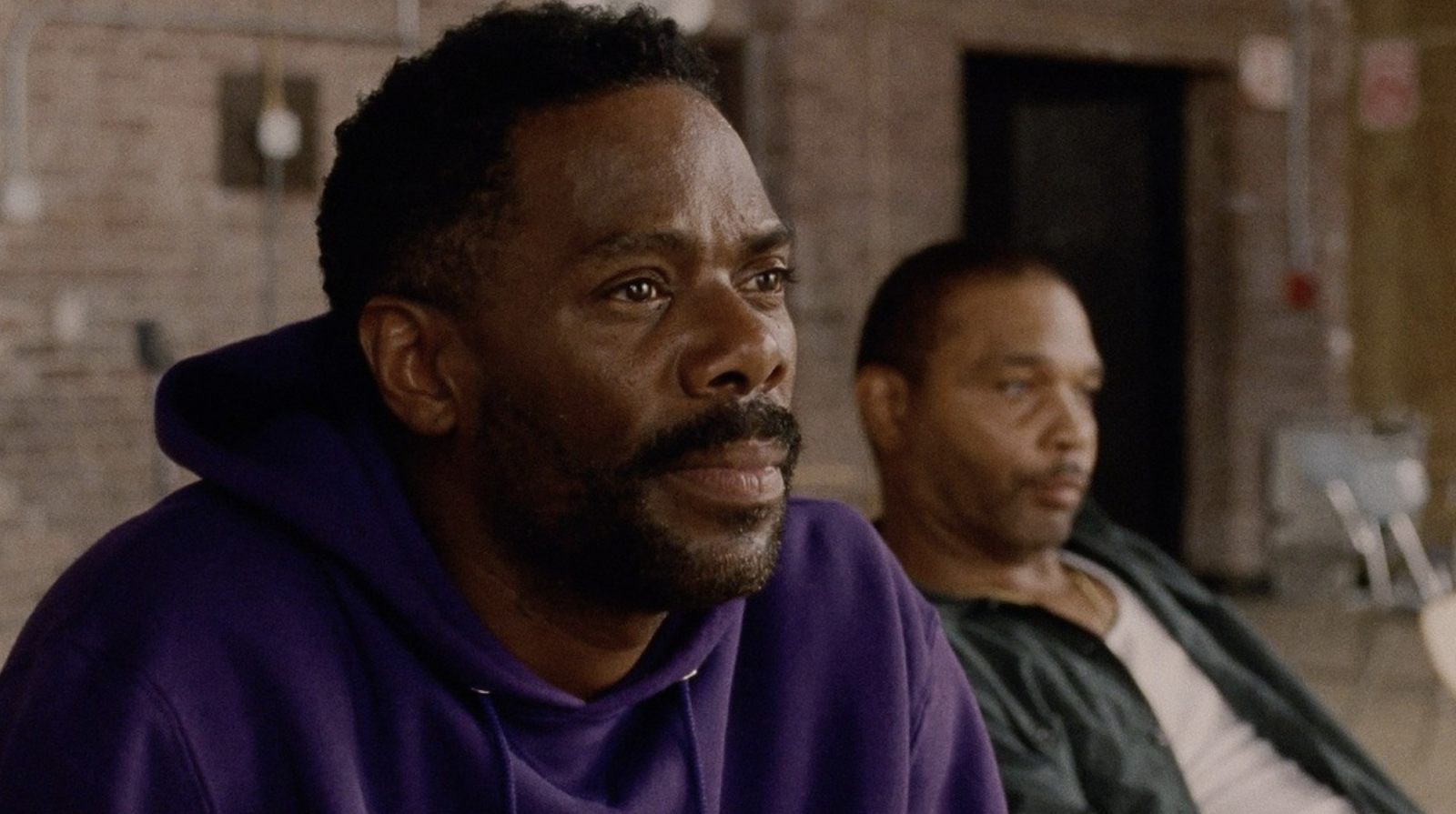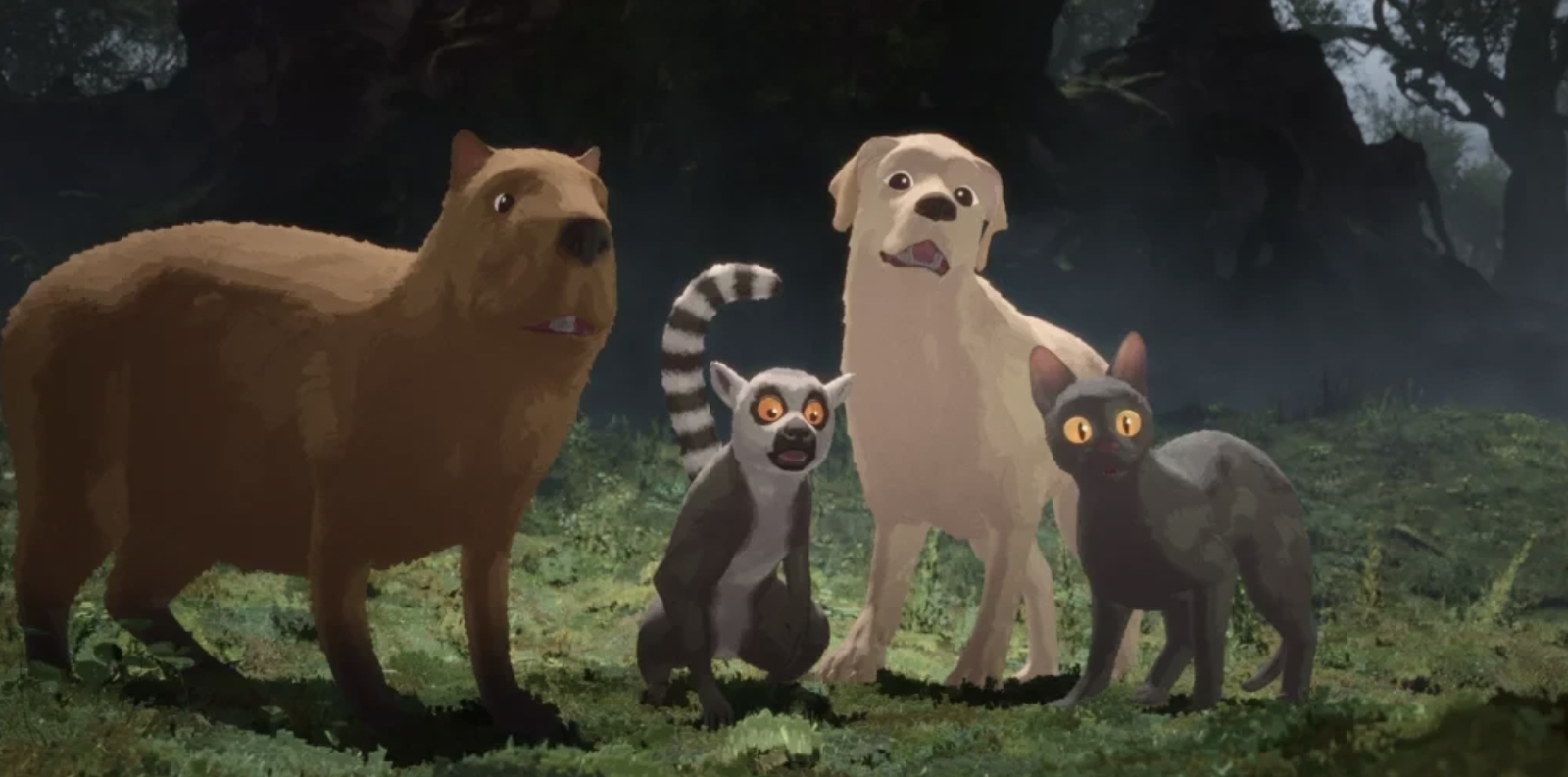 |
| Lupita Nyong'o in "The Wild Robot" Photo Credit: RottenTomatoes.com |
 |
| "Flow" Photo Credit: RottenTomatoes.com |
s a dark grey cat, a Labrador Retriever, a capybara, a secretarybird, and a ring-tailed lemur, as they navigate a perilous world that’s been devastated by a giant flood. “Flow” doesn’t have any dialogue, but through the animation, the characters are made as expressive as possible and are given actual animal noises that were recorded. The screenplay by Zilbalodes and Matīss Kaža takes a simple story that has the absence of dialogue allows for the narrative to unfold in subtle ways as you observe these characters and figure out the dynamics between them. The eye-catching animation absorbs you in the beauty and danger of the terrain that the animals travel, guiding the viewer through an adventure quite unlike anything you’ve seen in an animated film. “Flow” has its message come through without a single word, and this movie will leave you anticipating what Zilbalodes will say next.
 |
| Mark Eydelshteyn and Mikey Madison in "Anora" Photo Credit: RottenTomatoes.com |
 |
| John Magaro in "September 5" Photo Credit: Imdb.com |
7. September 5 - In 2005, Steven Spielberg delivered his gripping historical drama, “Munich,” which told the story of a group of Israeli assassins who go after the Black September militant group who killed 11 members of the Israeli Olympic team at the 1972 summer Olympics in Munich, Germany. Now, director Tim Fehlbaum brings us a film that tells the story of the ABC Sports news crew that told the story of the hostage crisis as it developed. Peter Sarsgaard and John Magaro deliver gripping performances as two of the top people in the crew who must make tough calls as the situation continues to escalate. The screenplay by Fehlbaum, Moritz Binder, and Alex David offers a captivating and tense view into its single-setting story as we watch everything happen in the news studio, while also giving us a chance to see who these characters are under the stress that they face. Throughout the film, Fehlbaum keeps the momentum going, always having us feel the time-sensitive nature of the scenario as it becomes more and more uncertain. It’s a powerful experience to see a world-changing event unfold, and with this film, you’ll feel like you’re right there.
 |
| Nicholas Hoult in "Nosferatu" Photo Credit: RottenTomatoes.com |
6. Nosferatu - The trend of Robert Eggers’ movies making my top 10 continues with his epic and disturbing remake of the iconic silent film from W.M. Mareau, which was an unauthorized adaptation of Bram Stoker’s iconic novel, “Dracula.” The story follows a young realtor, Thomas Hunter (Nicholas Hoult), who unwittingly sells a mansion in his town to a vampire, Count Orlok (Bill Skarsgård). This soon unleashes events more horrific than Thomas could’ve imagined. Hoult and Lily-Rose Depp (who plays his wife, Ellen) offer strong performances as the young couple at the center of Orlok’s terror, with Depp providing emotionally and physically demanding work that has your eyes glued to what she can do. For Orlok, Skarsgård absolutely sinks into the role, intimidating you with the darkness of his presence as he invades the lives of his intended victims. Eggers’ screenplay remains faithful to Mareau’s film, all while exploring the theme of repression that helped make Stoker’s novel so famous. Eggers exhibits the deep attention to period detail as he did in his previous films, transporting you to the world of the movie and leaving you more absorbed and frightened. Horror remakes rarely work, but if there was anyone who could pull it off, it was Eggers.
 |
| Colman Domingo and Clarence Maclin in "Sing Sing" Photo Credit: RottenTomatoes.com |
5. Sing Sing - When it comes to movies about the redemptive power of the arts, it’s always engaging to see how people’s lives can change when given an outlet to express themselves. In this drama from director Greg Kwedar, we follow John Whitfield (Colman Domingo), an inmate at the titular prison, who gathers his fellow inmates to put on a theatrical performance through the Rehabilitation Through the Arts program. Domingo gives a transcendent performance as a man who finds solace, possibility, and a sense of freedom in theater. Paul Raci gives a great supporting performance as the prison’s theater director, but most of the supporting cast is made up of former inmates portraying themselves, most notably Clarence Maclin, all of whom provide stunning emotional work. The screenplay by Kwedar and Clint Bentley does well in not just making this movie about its main character, but instead about all of the inmates, allowing us to get a sense who these people are, particularly in the audition scene and a mediation scene. Through this film, Kwedar creates an invigorating portrait of how the creative process can be therapeutic and encourage us to see the world in a whole new way, and in that, “Sing Sing” doesn’t make you feel anything less than alive.
 |
| Ralph Fiennes in "Conclave" Photo Credit: RottenTomatoes.com |
4. Conclave - The best thriller of the year comes from director Edward Berger, which is adapted from the 2016 novel by Robert Harris. The movie follows Cardinal Thomas Lawrence (Ralph Fiennes) who, following the pope’s death, leads a conclave to elect his successor, all while discovering secrets about some of the top candidates. Fiennes offers a captivating performance as a man who must make some difficult decisions and face difficult people. Meanwhile, Stanley Tucci and Isabella Rossellini offer great supporting performances as a fellow cardinal and the cardinals’ head nun. The screenplay by Peter Straughan constructs a thrilling and complex story that has you hooked as one revelation after another is made and threatens to complicate the papal voting process. It all culminates in a surprise ending that had my audience muttering in surprise when it was revealed. Berger maintains the white-knuckle tension throughout the film as matters become more difficult, while also knowing when to slow things down and create a sense of contemplation for the main character as he tries to keep everyone from turning against each other. This is a movie you’ll want to see as soon as you can because if there’s one recent film where you definitely don’t want the surprises spoiled for you, it’s this.
 |
| Mike Faist, Zendaya, and Josh O'Connor in "Challengers" Photo Credit: RottenTomatoes.com |
3. Challengers - One of the great powers that a sports movie can have is to get you interested in the sport that it depicts, even if you don’t follow it on a regular basis. The latest to accomplish that is Luca Guadagnino’s film about a complicated love triangle between an injured tennis star, Tashi (Zendaya), her tennis champion husband, Art (Mike Faist), and her less-talented tennis-playing ex-boyfriend, Patrick (Josh O’Connor). Zendaya gives an entertaining and layered performance as the woman in the middle of the romantic turmoil, while Faist and O’Connor have terrific chemistry in their humorous, yet tense competition that they have for tennis glory and Tashi’s affection. The screenplay by Justin Kuritzkes goes back and forth in time through the tumultuous relationship of the main characters, making you feel like you’re at a tennis match as you try to keep up with everything that’s happening and always keeping your eye on the ball. As a director, Guadagnino provides some of the best visuals of his career, immersing you in the thrilling action of the tennis matches and the romance that takes place off the court. “Challengers” isn’t your typical sports movie, and it’s all the better for it.
 |
| Timothée Chalamet and Zendaya in "Dune: Part Two" Photo Credit: RottenTomatoes.com |
2. Dune: Part Two - When director Denis Villeneuve released the first part of his two-movie adaptation of Frank Herbert’s iconic sci-fi novel in 2021, it was evident that the book was getting the big-screen treatment it deserved, and that continues with part two. The story follows Paul Atreides (Timothée Chalamet) as he continues to lead the rebellion against the evil House Harkonnen on the desert planet of Arrakis. Chalamet brings even more depth to his character in a performance that shows the massive changes in his arc. He’s backed up by a stellar supporting cast, with the standouts being Zendaya, Rebecca Ferguson, and Austin Butler, who relishes his psychotic villain role. Just like the first film, the screenplay by Villeneuve and John Spaihts includes enough of the details concerning the deep lore of the source material, while also making it accessible for moviegoers not familiar with it. As a director, Villeneuve further cements himself as a mammoth force in the sci-fi genre, building eye-popping visuals that have you feel the massive scale of the worlds within the film. With the stage set for “Dune: Messiah,” it’s clear Villeneuve has another epic installment in his hands.
 |
| Adrian Brody and Felicity Jones in "The Brutalist" Photo Credit: RottenTomatoes.com |
1. The Brutalist - This year gave us what will surely be considered one of the great American film epics with director Brady Corbet’s enthralling piece of historical fiction. The story follows a Hungarian-born architect, László Toth (Adrian Brody), who survives the Holocaust and immigrates to America. He’s soon given the chance to work on a massive construction project for his new acquaintance, Harrison Van Buren (Guy Pearce). Brody gives an inspirational and emotional performance of a man who tries to follow his dream in a country that might not accept him. Pearce is intimidating as Toth’s not-so-trustworthy employer, and Felicity Jones is wonderful as Toth’s wife, Erzsébet. The screenplay by Corbet and Mona Fastvold offers a sprawling view into the life of the main character, giving us a chance to see his arrival and assimilation into America in the first half, and then the unyielding passion for his work in the second act as he absorbs himself in his project. Corbet offers visuals that beg to be seen on a big screen, visuals that absorb you in how László takes in his new surroundings. This movie represents a filmmaker uncovering new heights with his talents, and there isn’t any doubt that he can, and will, go higher.









